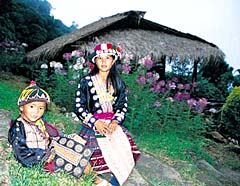 "A maple tree gave birth to a butterfly, which laid twelve eggs, one of which became Jiangyang, our forefather," explains clan elder Gun Genxiang, about the origins of people of Basha, a Miao hamlet.
"A maple tree gave birth to a butterfly, which laid twelve eggs, one of which became Jiangyang, our forefather," explains clan elder Gun Genxiang, about the origins of people of Basha, a Miao hamlet.
Though besieged by modernization, Miao people in the hamlet, in Congjiang County in southwest China's Guizhou Province, still keep alive their beliefs, rites and daily life.
Villagers still burn incense under ancient trees on festivals to pray for bliss.
"No one dares to cut any branch of an ancient tree, even if it is dead," said Jia Yuanliang, the village accountant and one of the few who can speak fluent Mandarin Chinese here in a place where people talk in the Miao language.
The ancient trees, including maples, firs, pines, and camphors, each hundreds of years old, have been protected as carriers of ancestor's spirits for generations.
Anyone who dares to cut any branch of the ancient trees will be penalized severely. They will have to give 60 kilograms of wine, meat and rice each to fellow villagers, a penalty also imposed in cases of crimes like theft, robbery or drug-taking, according to village rules.
As most of China's minorities carry on their traditional funeral ways, Miao people here still bury their dead in fir wood coffins.
Firs are the only wood used for this purpose and only those firs over 60 years are big enough, said Jia, adding that villagers plant trees for themselves or their descendants on hills every year.
Basha is a place where ancient culture is most completely protected, and this group is quite different from other Miao groups in terms of clothing and daily life, said Zhang Xiaosong, a respected anthropologist in the province.
They dress like ancient warriors, wearing guns and knives everyday. Their clothes, made in the village, are dyed a glittering sapphire color with indigo blue and egg white. The hair on their heads is mostly shaved except in the middle, where it is twisted and knotted.
The 2,140 villagers, more like a tribe, seldom connect with the outside world and lead a self-sufficient life in the hilly areas.
Basha is about seven kilometers away from the center of the county and has been crossed by a highway for over 30 years.
(China Daily October 28, 2002)
|

